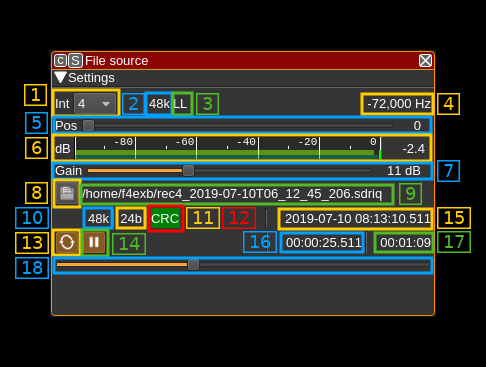| .. | ||
| CMakeLists.txt | ||
| filesource.cpp | ||
| filesource.h | ||
| filesourcebaseband.cpp | ||
| filesourcebaseband.h | ||
| filesourcegui.cpp | ||
| filesourcegui.h | ||
| filesourcegui.ui | ||
| filesourceplugin.cpp | ||
| filesourceplugin.h | ||
| filesourcereport.cpp | ||
| filesourcereport.h | ||
| filesourcesettings.cpp | ||
| filesourcesettings.h | ||
| filesourcesource.cpp | ||
| filesourcesource.h | ||
| filesourcewebapiadapter.cpp | ||
| filesourcewebapiadapter.h | ||
| readme.md | ||
File source channel plugin
Introduction
This plugin reads a file of I/Q samples that have been previously saved with the file record button of other sampling source devices. The file starts with a 32 byte header of all unsigned integer of various sizes containing meta data:
| Displ. | Bytes | Description |
|---|---|---|
| 0 | 4 | Sample rate in S/s |
| 4 | 8 | Center frequency in Hz |
| 12 | 8 | Unix epoch (timestamp) of start |
| 20 | 4 | Sample size (16 or 24 bits) |
| 24 | 4 | Filler with zeroes |
| 28 | 4 | CRC32 of the previous 28 bytes |
The header takes an integer number of 16 (4 bytes) or 24 (8 bytes) bits samples. To calculate CRC it is assumed that bytes are in little endian order.
The I/Q samples are copied to the baseband to be transmitted by the sink output device with possibly a chain of half-band interpolators for upsampling and shift of bandwidth.
Interface
1: Interpolation factor
The device baseband can be interpolated from the channel and its center can be selected with (5). The resulting sample rate of the I/Q stream pulled from the Local Output device sink is the baseband sample rate divided by this value. The value is displayed in (2).
2: I/Q stream sample rate
This is the sample rate in kS/s of the I/Q stream pulled from the Local Output device sink instance.
3: Half-band filters chain sequence
This string represents the sequence of half-band filters used in the interpolation. Each character represents a filter type:
- L: lower half-band
- H: higher half-band
- C: centered
4: Center frequency shift
This is the shift of the channel center frequency from the device center frequency. Its value is driven by the device sample rate, the interpolation (1) and the filter chain sequence (5).
5: Half-band filter chain sequence
The slider moves the channel center frequency roughly from the lower to the higher frequency in the device baseband. The number on the right represents the filter sequence as the decimal value of a base 3 number. Each base 3 digit represents the filter type and its sequence from MSB to LSB in the filter chain:
- 0: lower half-band
- 1: centered
- 2: higher half-band
6: Level meter in dB
- top bar (green): average value
- bottom bar (blue green): instantaneous peak value
- tip vertical bar (bright green): peak hold value
You must make sure that the peaks do not exceed 0 dB. In fact you should have 1 or 2 dB reserve when you tune the power level with the gain slider (7)
7: Gain
You may use this control to apply a gain to the input signal. You can control the resulting channel power with (6).
8: Open file
Opens a file dialog to select the input file. It expects a default extension of .sdriq. This button is disabled when the stream is running. You need to pause (button 11) to make it active and thus be able to select another file.
9: File path
Absolute path of the file being read
10: File recorded sample rate
Sample rate of the record in kS/s as written in the header. The reading process is based on this sample rate.
11: Sample size
This is the sample size in bits as written in the header. The reading process is based on this sample size.
12: CRC indicator
Indicates if the header block CRC check has succeeded (green) or failed (red) or undetermined yet (grey). If the header is corrupted you may try to reconstruct a valid header using the rescuesdriq utility in the folder with the same name. See the readme for details.
13: Loop
Use this button to read in a loop or read only once
14: Play/pause
This is the play/pause button
15: Current timestamp
This is the timestamp of the current pointer in the file based on the start time, number of samples read and sample rate.
16: Relative timestamp
Left is the relative timestamp of the current pointer from the start of the record.
17: Record length
This is the total record time.
18: Current pointer gauge
This represents the position of the current pointer position in the complete recording. It can be used it paused mode to position the current pointer by moving the slider.
